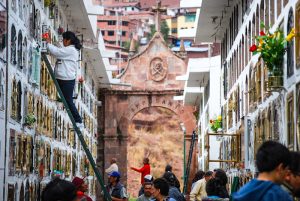Day of the Living and the Dead

Peruvians traditionally danced and feasted with their dead. They would keep them in caves or mausoleums, such as the circular ones called ch’ullpas, as well as in special buildings, until a feast day. Then the dead, preserved as mummies would come out to enjoy the celebration, chicha and food, with their descendants.
Communities were called allus and each was organized around feasting certain ancestors, what anthropologists often call apical ancestors, those who stand at the top of a pyramid of descendants whose life develops around celebrating this ancestor who is still present though in a different form.
The Spanish, in their complexity and desire to create a new Spanish, Catholic domain in Peru, worked to stamp out these ancestor celebrations and burn the mummies. They tried to get the Peruvians to bury their dead in churches or in cemeteries and leave them, instead of disinterring them for celebration. It took a long time and a crisis in which people came not to trust their ally’s or the ally leadership, but by the beginning of the eighteenth century throughout the Andes people had adopted different relationships with the dead.
Still they feast them, thanks in part to the Spanish Catholic feast of All Souls. In Europe it comes at the beginning of winter, while in the Andes it comes early in the spring, as the crops are becoming abundant. Nevertheless, this feast, whether marking the coming of cold and dark, or growth and fertility, enabled Peruvians to continue a tradition of having their dead present and sharing their abundance with them.

Though the mummies were burned, the ancient dead have not gone away. They still exist as machus, ancient one who exist underground or who roam the earth. They are dangerous and can harm the unwary, as well as impregnate un-cautious women. The past is not gone, it is only beneath the skin of the earth and on the other side of the boundaries of day and night.

The folklore of the machos marks a boundary between the pre-Christian dead and their descendent who are now Christian, though still Peruvian and still Andean.
In Cusco, the feast of All Souls is divided so that it celebrates all of the kin who are living in traditional Cuzco fashion, with a meal and with laughter and drink. The foods offered are deeply traditional and very conservative. You have lechón which is roast pork, especially a tender, young pig, which has gone through a double process of transformation. It is seasoned and left to cure in daylight under the transformative powers of the sun before going into a dark oven and being baked as if it had gone into a womb to be reborn. And you eat tamales, two of them since dualism is part of the sacred character of life. The tamales are also transformed from ground corn. They are made into a dough and then placed inside a corn husk and given a separate filling inside the corn, before being steamed. As a result, the meal consists of a whole: food prepared through wet and dry cooking processes inside closed containers.
Although people tend not to make this analysis it seems evident to one who looks that on this feast when people celebrate first with their living and then with their dead, that the meal itself encloses much meaning. It is about life and death, since both are present today, like wet and dry; two seasons, two stages of life.

But there is another dualism. The doubled meal of lechón and tamales, set in the sacred number of three recreates the sacred idea of three: a upset (the tamales) and a whole (the lechón). Catherine Allen, following Gary Urton, makes much of these numbers in her brilliant book simply called Foxboy.
But, in true Cuzco fashion there is more. Today people will also give bread babies (t’anta wawas) to girls and bread horses (pan caballos) to boys. These are sweetened, formed breads that represent new-ness, the coming of new life at the time we celebrate ancestors. This is another dualism, the dead and the new born, on top of the dualism of earth and sky. The babies are represented as bundled up in a carrying cloth, as if still in an earth like womb or like a mountain, while the horses relate to the thundering power of lightning and the sky. The horse, though Spanish in origin, came quickly to be associated with men and with the sky god Illapa. In Spanish the image is of Saint James, Santiago the Spanish patron saint, also known as Santiago the Indian killer.

Of course we also have the dualism of women standing for the indigenous and men for the Spanish who, as Peter Gose notes, came to be considered people’s ancestors.
People will gather to baptize these new bread children fresh out of the ovens of Cuzco, in a ritual model of people’s own lives, replete with compadres and padrinos, spiritual kin. It is fun yet serious, just as the humor and laughter of today when people celebrate the living is also serious as a focused effort to create a good life filled with joy.
References:
Catherine J. Allen, Foxboy, Intimacy and Aesthetics in Andean Stories (University of Texas Press, 2011)
Peter Gose, Invaders as Ancestors, on the Intercultural Making and Unmaking of Spanish Colonialism in the Andes (University of Toronto Press, 2008)




